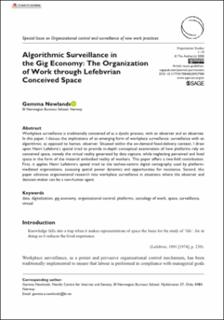| dc.description.abstract | Workplace surveillance is traditionally conceived of as a dyadic process, with an observer and an observee. In this paper, I discuss the implications of an emerging form of workplace surveillance: surveillance with an algorithmic, as opposed to human, observer. Situated within the on-demand food-delivery context, I draw upon Henri Lefebvre’s spatial triad to provide in-depth conceptual examination of how platforms rely on conceived space, namely the virtual reality generated by data capture, while neglecting perceived and lived space in the form of the material embodied reality of workers. This paper offers a two-fold contribution. First, it applies Henri Lefebvre’s spatial triad to the technocentric digital cartography used by platform mediated organisations, assessing spatial power dynamics and opportunities for resistance. Second, this paper advances organisational research into workplace surveillance in situations where the observer and decision-maker can be a non-human agent. | |
